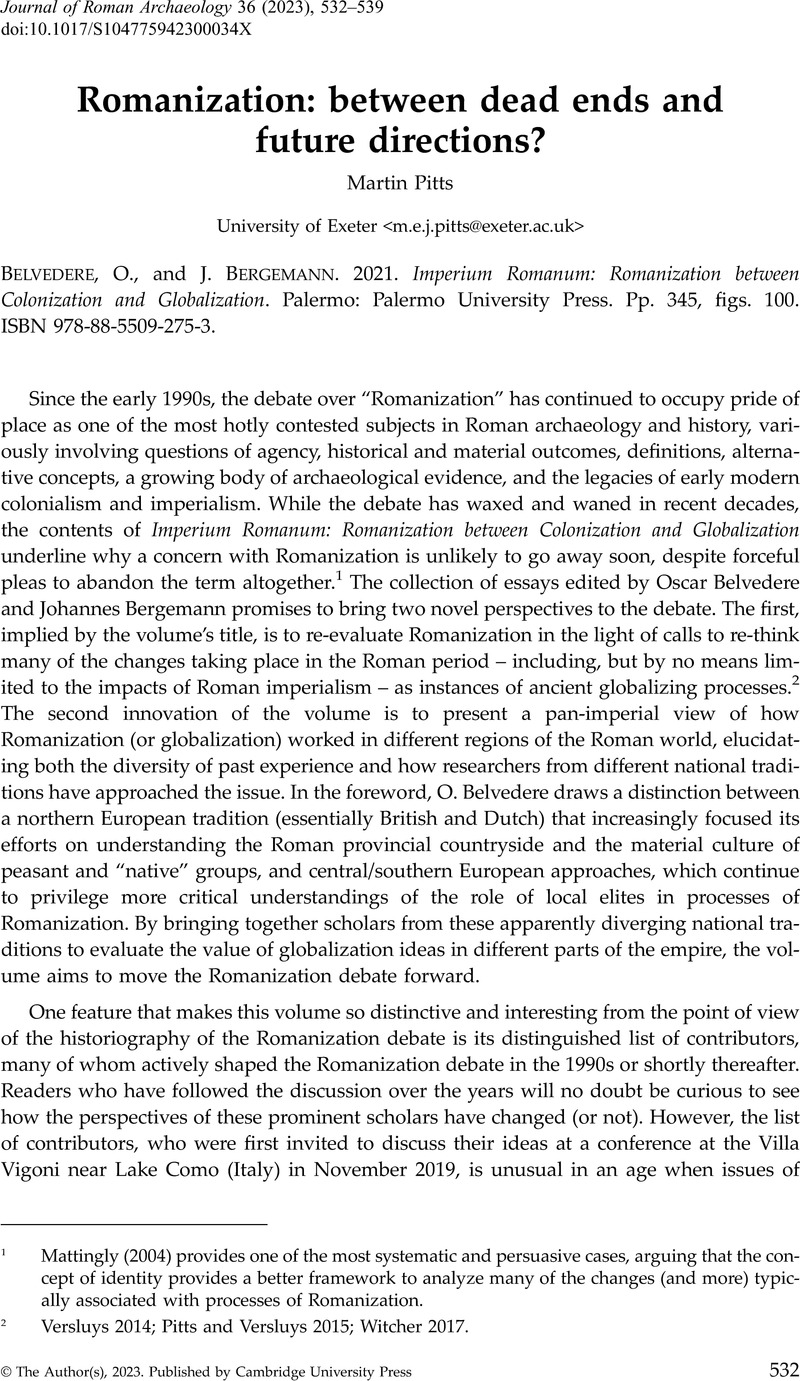No CrossRef data available.
Article contents
Romanization: between dead ends and future directions? - O. Belvedere, and J. Bergemann. 2021. Imperium Romanum: Romanization between Colonization and Globalization. Palermo: Palermo University Press. Pp. 345, figs. 100. ISBN 978-88-5509-275-3.
Review products
O. Belvedere, and J. Bergemann. 2021. Imperium Romanum: Romanization between Colonization and Globalization. Palermo: Palermo University Press. Pp. 345, figs. 100. ISBN 978-88-5509-275-3.
Published online by Cambridge University Press: 07 September 2023
Abstract
An abstract is not available for this content so a preview has been provided. Please use the Get access link above for information on how to access this content.

- Type
- Book Review
- Information
- Copyright
- Copyright © The Author(s), 2023. Published by Cambridge University Press
References
Eckardt, H. 2005. “The social distribution of Roman artefacts: The case of nail-cleaners and brooches in Britain.” JRA 18: 139–60.Google Scholar
Eckardt, H., ed. 2010. Roman Diasporas. Archaeological Approaches to Mobility and Diversity in the Roman Empire. JRA Suppl. 78. Portsmouth, RI: Journal of Roman Archaeology.Google Scholar
Eckardt, H. 2014. Objects and Identities. Roman Britain and the North-Western Provinces. Oxford: Oxford University Press.CrossRefGoogle Scholar
Fernández-Götz, M., Maschek, D., and Roymans, N.. 2020. “The dark side of the Empire: Roman expansionism between object agency and predatory regime.” Antiquity 94, no. 378: 1630–39.CrossRefGoogle Scholar
Gardner, A. 2003. “Seeking a material turn: The artefactuality of the Roman Empire.” In TRAC 2002: Proceedings of the Twelfth Annual Theoretical Roman Archaeology Conference, Canterbury 2002, ed. Carr, G., Swift, E., and Weekes, J., 1–13. Oxford: Oxbow Books.Google Scholar
Gardner, A. 2013. “Thinking about Roman imperialism: Postcolonialism, globalisation and beyond?” Britannia 44: 1–25.CrossRefGoogle Scholar
Gosden, C. 2004. Archaeology and Colonialism. Cultural Contact from 5000 BC to the Present. Cambridge: Cambridge University Press.Google Scholar
Gosden, C. 2005. “What do objects want?” Journal of Archaeological Method and Theory 12: 193–211.CrossRefGoogle Scholar
Hales, S., and Hodos, T., eds. 2010. Material Culture and Social Identities in the Ancient World. Cambridge: Cambridge University Press.Google Scholar
Hodos, T., with Geurds, A., Lane, P., Lilley, I., Pitts, M., Shelach, G., Stark, M., and Versluys, M. J., eds. 2017. The Routledge Handbook of Archaeology and Globalization. London: Routledge.Google Scholar
Hopkins, K. 1980. “Taxes and trade in the Roman Empire 200 B.C.–A.D. 400.” JRS 70: 101–25.Google Scholar
Mattingly, D. J. 2004. “Being Roman: Expressing identity in a provincial setting.” JRA 17: 5–25.Google Scholar
Millett, M. 1990a. “Romanization: Historical issues and archaeological interpretation.” In The Early Roman Empire in the West, ed. Blagg, T. and Millett, M., 35–41. Oxford: Oxbow.Google Scholar
Millett, M. 1990b. The Romanization of Britain. Cambridge: Cambridge University Press.Google Scholar
Naerebout, F. G. 2006–2007. “Global Romans? Is globalisation a concept that is going to help us understand the Roman empire?” Talanta 37–38: 149–70.Google Scholar
Nederveen Pieterse, J. 2015. “Ancient Rome and globalisation. Decentring Rome.” In Globalisation and the Roman World. World History, Connectivity and Material Culture, ed. Pitts, M. and Versluys, M. J., 225–39. Cambridge: Cambridge University Press.Google Scholar
Pitts, M. 2015. “Globalisation, circulation and mass consumption in the Roman world.” In Globalisation and the Roman World. World History, Connectivity and Material Culture, ed. Pitts, M. and Versluys, M. J., 69–98. Cambridge: Cambridge University Press.Google Scholar
Pitts, M., and Versluys, M. J., eds. 2015. Globalisation and the Roman World. World History, Connectivity and Material Culture. Cambridge: Cambridge University Press.Google Scholar
Pitts, M. 2019. The Roman Object Revolution. Objectscapes and Intra-Cultural Connectivity in Northwest Europe. Amsterdam Archaeological Studies 27. Amsterdam: Amsterdam University Press.Google Scholar
Scheidel, W. 2014. “The shape of the Roman world: Modelling imperial connectivity.” JRA 27: 7–32.Google Scholar
Tsing, A. L. 2005. Friction: An Ethnography of Global Connection. Princeton: Princeton University Press.CrossRefGoogle Scholar
Van Oyen, A., and Pitts, M., eds. 2017. Materialising Roman Histories. Oxford: Oxbow Books.CrossRefGoogle Scholar
Van Oyen, A. 2017. “Material culture in the Romanization debate.” In The Diversity of Classical Archaeology, ed. Lichtenberger, A. and Raja, R., 287–300. Turnhout: Brepols.Google Scholar
Versluys, M. J. 2014. “Understanding objects in motion. An archaeological dialogue on Romanisation.” Archaeological Dialogues 21: 1–20.CrossRefGoogle Scholar
Versluys, M. J. 2015. “Roman visual material culture as globalising koine.” In Globalisation and the Roman World. World History, Connectivity and Material Culture, ed. Pitts, M. and Versluys, M. J., 141–74. Cambridge: Cambridge University Press.Google Scholar
Wallerstein, I. 1974. The Modern World-System I: Capitalist Agriculture and the Origins of the European World-Economy in the Sixteenth Century. New York: Academic Press.Google Scholar
Witcher, R. E. 2017. “The globalized Roman world.” In The Routledge Handbook of Archaeology and Globalization, ed. Hodos, T., with Geurds, A., Lane, P., Lilley, I., Pitts, M., Shelach, G., Stark, M., and Versluys, M. J., 634–51. London: Routledge.Google Scholar
Woolf, G. 1998. Becoming Roman. The Origins of Provincial Civilization in Gaul. Cambridge: Cambridge University Press.CrossRefGoogle Scholar




